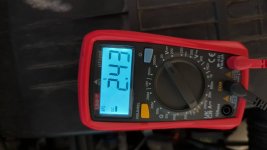First, define the problem. Your thread starts with vague question about voltages. Wrong approach.
Do you have an engine problem, for example it lacks power, has
fault codes etc.?
Basic diagnosis can be done via FES or
MES. Timing should be about 106 degrees (VVT1 position), camshaft positions real and desired very close while control is zero (0%) at idle. That's all. VVT starts to operate from about 2000-ish RPM. Example data (test drive).
Most control circuits are ground side switches (not always true but in general).
Means the device under control is "hanging" on the positive rail, ECU completes the circuit to ground.
Normally you don't care what the voltages are on the open circuit. Plug the VVT solenoid valve and then check if it gets power!
Control circuits for inductive loads must have some "kickback" protection (overvoltage), making the circuit more "complicated" and messing with the multimeter readings (due to high input impedance, typically 1 or 10 Mega ohms). Some circuits have also a feedback (they are monitored), that will introduce some voltage shift (or "drop") too.
Some sensors are "floating" too. For example crankshaft sensor (classic, 2-pin) has "weird" voltages on the pins while unplugged. So what? Nothing!
We care about the signal produced by sensor, not open circuit readings. Same with actuators (solenoids, motors, coils, relays).
Testing under load is the proper way (only then we can draw conclusions).
PS
Czechosłowacja? Check this Polish forum:
https://fiatpunto.com.pl/forum37.html A lot of detailed Guides like that (VVT, timing, and so on).
EDIT: Voltages.
When ignition is OFF, voltages are close to zero (single mV) on both pins.
Ignition ON gives about 2,4 V on one pin. Negative multimeter lead on the battery negative pole of course.
Other pin shows 12,0 Volts. Which is exactly battery level (yes, mine needs a charging, like NOW).
There is no drop! You have a problem.
Voltage directly between the pins will be a difference (12,0 - 2,4 = 9,6 V).
How the VVT proportional valve moves. Adjustable "PWM" source (you can test it also using direct 12 Volts, check if it moves).



